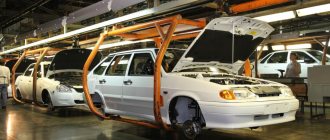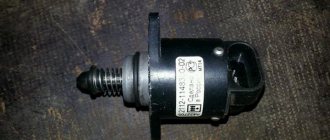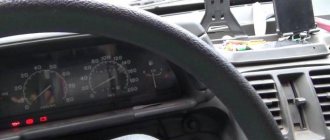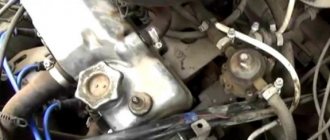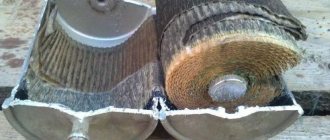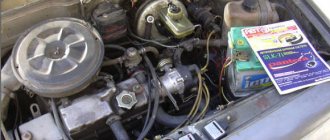MAIN REASONS WHEN THE CAR STALLS AT IDLE SPEED
A VAZ car stalls at idle quite often when there is a malfunction of sensors, components or parts. It is also possible that the car's lines, filters, and various elements in the system become contaminated.
If any of the VAZ models, including the Chevrolet Niva, stalls at idle, then first of all you should pay close attention to the quality of gasoline. Problems with starting or incorrect operation of the engine after the next refueling may arise precisely because of low-quality fuel. In this case, it is worth draining all the gasoline and changing the fuel filter.
When these steps do not help, you need to check the spark plugs in the car. The working part is distinguished by the light gray color of the central electrode. The carbon deposits on the candles should be light brown. In case of any deviations from the norm, we can assume that the part has failed. Replace the spark plugs and try to start the engine again.
A faulty ignition module can also cause problems with starting the engine. Knowledge of at least a minimum of electrical engineering will allow you to check its performance. But it is better to contact a specialized service.
A generator malfunction leads to a decrease in the bot network voltage. In this case, all vehicle systems are powered by the battery. This is also the reason why a car stalls at idle when hot. On the instrument panel indicators of some models you can see a decrease in the mains voltage. Here it is worth diagnosing the generator for the presence of a breakdown.
What are the reasons leading to incorrect engine operation:
- The throttle valve is broken or dirty.
- Contamination in the crankcase ventilation.
- Malfunction of the throttle position sensor or mass fuel flow sensor, other indicators.
- Faulty or clogged parts of the idle air regulator.
- Carburetor channels are clogged with sediment.
- Fuel nozzle clogged.
- Debris or errors in the operation of injection nozzles.
- Faulty or dirty fuel pump filter mesh.
- Fuel filter is dirty.
If the engine stalls at first, but then starts
Incorrect firmware of the electronic engine control unit may prevent the car from idling correctly. Incorrect firmware of the electronic engine control unit may prevent the car from idling correctly. This happens when a vehicle is subjected to unreasonable tuning. As a result, the car can produce decent dynamics at high speeds, but it can no longer hold 1000 rpm and stalls.
This problem is solved by flashing the ECU in accordance with the factory version of the program.
But most often, such troubles still arise due to the unstable operation of certain sensors. First of all, this is a mass air flow sensor (MAF), as well as a throttle position sensor (TPS). It is also necessary to mention the idle speed controller (IAC), which is popularly called the “idle speed sensor”. All these elements require regular diagnostic testing. In case of emergency, it is convenient to have a spare set of the listed sensors, especially since their cost for almost all brands of cars is low.
OPTIONS FOR TROUBLESHOOTING
It is clear that if any emergency situations arise with the motor, it is advisable to contact a specialized service. However, this procedure is not always possible. Therefore, it is worth knowing how to independently diagnose the main systems and key parts.
THROTTLE VALVE AND ASSEMBLY
When the speed drops at idle and the car stalls, you need to pay close attention to the details of the throttle assembly. Long-term operation of the car on low-quality fuel and untimely maintenance of the air filter can lead to malfunctions of the throttle valve. It periodically jams if debris gets into the equipment.
Throttle valve VAZ 2112
The problem can be solved by cleaning the system. The throttle is cleaned using carburetor cleaners. Using a compressor, you need to blow out the damper under the pressure of compressed air. It is not recommended to touch the screws located inside and on the side. If cleaning does not correct the situation, the device must be replaced. This operation is not particularly difficult.
CRANKCASE FAILURE
There is an oil trap in the crankcase ventilation system of the engine. Its contamination can also lead to interruptions in engine operation. Crankcase gases do not allow the engine to function normally, the speed fluctuates, the internal combustion engine stalls.
SENSORS
If a gasoline car stalls at idle, then one of the sensors is likely to break. In injection cars with an electronic engine control system, the engine usually starts normally, but then it stops working. It's worth checking here:
- Electronic car indicators;
- DRХХ – device that regulates idle speed;
- Air flow meter (air intake in the carburetor);
- Sensor indicating the position of the throttle curtain.
Electronic control unit in VAZ 2114
Interruptions in the operation of any sensors immediately affect the behavior of the electronics - errors appear in the car control unit. The “brains” of the machine receive unreliable information. It is not transmitted correctly to the engine. It starts working with parameters that do not correspond to reality. Self-testing of this device is not possible. You need to contact a professional for service.
Diagnostics of mass air flow sensor
The idle air control device is usually to blame for engine malfunction when the car idles poorly. But you pressed the gas pedal and the engine started. In the latest VAZ modifications, error information appears on the instrument panel.
When diagnosing, you must use a multimeter. If a part is faulty, it is recommended to replace it with a new one. All sensors are reasonably priced. It is better to start checking with parts that have a simpler design. Then gradually move on to complex devices. We must not forget that the problem may lie not only in the sensors themselves. It is also necessary to check the wiring to them and the presence of stable contact.
CARBURETOR
If the VAZ carburetor stalls at idle speed, then the jets may become clogged. Low-quality gasoline, deposits from the gas tank, contain small particles of debris. They can easily disrupt the operation of the fuel injection system. It is worth replacing the filter in front of the carburetor and cleaning the device itself. The dispensing part is cleaned using a cleaning solvent, which is sold in aerosol cans. Another reason is often a prolonged lack of carburetor adjustment.
In a mechanical fuel pump of carburetor cars, the filter mesh may be clogged with dirt. This reduces the performance of the device. Wear of the membrane and its destruction often leads to clogged carburetor channels.
INJECTOR
A situation that often arises is that various Lada models, as well as the VAZ 2110 injector stalls at idle. It is necessary to check the fuel pump strainer for clogging. This is a common problem with injection machines. It is better to immediately replace the part with a working one.
FILTERS PROBLEM
If the VAZ 2112 stalls at idle, then the fuel filter may be dirty. This also applies to other models of the concern. Generally, it is not practical to clean it. The part must be replaced. The same should be done with a dirty air filter. Low throughput leads to the fact that the air-fuel mixture simply floods the spark plugs.
Self-checking will not always lead to a positive result. It is often more practical to identify the cause of unstable operation of the internal combustion engine at a car service center. It will cost more, but specialized diagnostics will prevent more serious damage to the car.
Self-diagnosis of ICC
To understand that this particular unit is the cause of a stalled engine, it is enough to pay attention to several signs:
- The car's power unit stops working as soon as one of the gears is turned off.
- The revolutions begin to “float”.
- When XX is activated, the motor begins to malfunction.
- As soon as the car owner starts the engine when it is cold, it becomes impossible to increase the speed.
- When the driver turns on the headlights or other light optics, the engine speed begins to drop noticeably.
VAZ 2115 stalls at idle - reason
- Wash the throttle assembly, especially pay attention to the channels xx, where the low speed regulator is located. Wash the IAC itself. Check the TPS sensor. Look for air leaks, check the mass air flow sensor. Check coolant temperature sensor.
- I once changed about five TPS, from the cheapest to the most expensive, and everyone behaved differently. They have a little travel to adjust, try making the revs a little higher.
- Well, suction cannot be ruled out throughout the entire intake tract. Do you have a recirculation valve? The tube comes to it from the receiver, try turning it off.
- With a non-working automatic transmission, the car will not start at all, much less go anywhere. Moreover, the ECU constantly monitors its operation and, if something happens, will turn on the meat grinder on the panel for you.
- According to check: when the ignition is on, there should be 0.7 volts between ground and the TPS slider, and 4 volts with the throttle fully open.
- I don’t know whether there are many or few defects, but I came across two in a row through which air was sucked in the place where the rivets were, both with a hologram and with an authentication code. I returned one, the second, because I took it apart, naturally did not return it, but covered the crack with nail polish.
- But you may have another reason; I haven’t tried it with the connector removed. Just in case, check it for leaks.
- No, there is no relay, there is a stepper motor, controlled by the ECU.
- The ECU issues control signals to the stepper motor, in which direction and how many steps to turn the motor rotor, and it, in turn, moves the rod, opening or closing the xx channel. Operating a ball motor is not like operating a regular motor. Or do you think that the ECU may not be giving a signal? Then you need to diagnose or borrow a BC, it will be able to show the operation of the IAC.
In this article we will talk about such an unpleasant problem as engine stopping and poor starting. Let's look at the main reasons why the engine stalls at idle and while driving. In addition, we will talk about why the engine does not start when hot, as well as options for solving each of the problems described above.
VAZ 2115 idle speed disappears, injector 8 valves
If there was a mesh in the tank, then the car would be dull even when accelerating, wouldn’t it?
I experienced what a clogged mesh is like last year. With it, the car either drives or doesn’t drive at all, that is, the interruptions generally start to be terrible, and especially when, of course, you add gas. But at XX it is just more stable.
DMRV is also unlikely. Simply, by removing the connector, you started the controller to bypass the air flow readings. And he takes the average value and keeps the XX speed deliberately high so as not to stall.
When you release the brake pedal at idle, there is a quick and slight jump in revolutions. From 850 to 1000 approximately.
But this is alarming! There shouldn't be such a leap! Even if there is one, the tachometer needle doesn’t even have time to move away. Well, personally, I have nothing. If you vote, then I personally am for sucking VUT!
Recently, there was also such a problem with stalling. Yesterday I got around to taking a look. And the first thing I noticed was the nipple on the VUT, where the hose from the receiver is connected. My hose was slightly shortened and touched the engine (remote control corrugations), which even rubbed off the braid. Well, apparently, while the engine was fidgeting back and forth during acceleration and deceleration, he was dragging the hose along with him, which already wore out the rubber band in the VUT, where this pipe is stuck. I had a spare one from a repair kit, so I replaced it. Today I rode - not a single sign of stalling or slowing down. But there may be something else with VUT.
I experienced what a clogged mesh is like last year. With it, the car either drives or doesn’t drive at all, that is, the interruptions generally start to be terrible, and especially when, of course, you add gas. But at XX it is just more stable.
Yes, they don’t believe it. Those. and if in general, the fuel pressure is most likely all normal. Actually, the car stalls.
DMRV is also unlikely. Simply, by removing the connector, you started the controller to bypass the air flow readings. And he takes the average value and keeps the XX speed deliberately high so as not to stall.
That's how it is, but still, if there is no gasoline, then air remains. I mean there's a lot of it. My throttle is relatively clean; the last time I was struggling with trouble, I took it off. I also seem to have changed the IAC.
And in general. To increase the speed after pulling off the mass air flow sensor, you need the IAC to move. And once they rise and the car drives normally and switches to XX, that means the IAC channel opens. By the way, in this mode it shows 120 steps.
When you release the brake pedal at idle, there is a quick and slight jump in revolutions. From 850 to 1000 approximately.
But this is alarming! There shouldn't be such a leap! Even if there is one, the tachometer needle doesn’t even have time to move away. Well, personally, I have nothing. If you vote, then I personally am for sucking VUT!
There may also be a leak. But somehow, for half a year now, it has been manifesting itself periodically, and not to say that often. Oh, another moment. When there is suction, the mixture seems to become poorer.
And I remember the last time when it started stalling, as soon as I got home I unscrewed the spark plugs - they were pretty black. Why did I then also think that as an option, gasoline injectors, pressure, etc. But now I'm not sure.
Source
Common reasons why the idle stalls:
1. The most common one is the idle speed regulator (sensor), which is directly related to engine idle speed. It’s quite easy to check whether there is a breakdown. If the car does not start when you turn the starter, operate the gas pedal, the engine should start. If the revs start to fluctuate immediately after you take your foot off the pedal, there is a 99% chance that the reason is in the idle speed control. The solution is to replace the idle air control; this will take VAZ owners a minimum of time.
2. The second probable reason why the engine stalls at idle is problems with the throttle valve. This problem can be cured by simply cleaning the throttle valve.
3. If after cleaning the problem persists, we assume that the reason why the engine stalls at idle may be the TPS (throttle position sensor). The problem is solved by replacing the TPS; the procedure is not complicated and can actually be done with your own hands.
There are often cases when the engine stalls while driving, as they say, out of the blue. The most probable and most common reasons why this may happen will be listed below.
The car does not start for a long time and stalls immediately after turning off the starter
Sometimes it happens that the engine either refuses to slow down when you release the gas pedal, or, on the contrary, suddenly stalls at idle. A significant proportion of these cases are due to a faulty engine throttle valve. In other words, it is clogged and jammed.
This can occur due to prolonged driving on low-quality fuel, of which we have plenty, as well as from dirt impurities in the air entering through the air filter.
This problem can be mitigated by regular cleaning of the throttle valve. To do this, it is recommended to use a universal cleaner for purging carburetors and other car parts; it comes in metal cans and is sold at any auto supply store. It is also worth paying attention to the inevitable clogging of the oil trap in the crankcase ventilation system, as this is just a matter of time. If the filter becomes dirty, the engine literally begins to choke from excess crankcase gases, as a result of which it does not hold idle speed and stalls. The crankcase ventilation filter must be washed regularly.
The engine stops while running - reasons
1. Poor quality fuel is the first thing that comes to mind for most of us, and besides, this is where we need to start looking for the reason for the engine stopping while driving. You will be “lucky” if this happens immediately after refueling, in which case you can confidently say that the problem is in the fuel. Treated by draining the fuel and replacing the fuel filter.
2. Candles. As a rule, suspicion most often falls on them, after bad fuel, of course. Everything is simple here - unscrew the spark plugs and check their condition, replace the spark plugs if necessary.
3. Fuel filter. A seriously clogged filter can cause an interruption in fuel supply, causing you to rev the gas and the engine to stall while driving. To eliminate the problem, simply replace the fuel filter.
4. Air filter. Everything is the same as with the fuel, if it is clogged, then no air comes in, therefore the fuel-air mixture comes out over-enriched and the spark plugs simply flood. In addition, due to lack of air, the engine will choke, that is, the power will drop, and the combustion process of the mixture in the cylinders will not be able to take place, and eventually the engine will stall. To eliminate this problem, simply replace the air filter.
5. A faulty fuel pump is the second “suspect.” If your fuel pump is not working properly, then the car will behave like this, stalling while driving, or the engine will not start at all. The problem can be solved by checking the pump, repairing it, or completely replacing the fuel pump.
6. Battery. Oxidation of the battery terminals or poor contact can cause the engine to stall. Check the terminals, clean them if necessary or replace the battery.
7. If the engine stalls while driving and no longer starts, the generator may also be the cause. A failed generator does not charge; as a result, the car’s on-board network is powered exclusively by the battery, and as we know, it will not last long. As a result, you, unaware that the car is running on the battery, continue driving until it is completely discharged. It can be treated by charging the battery and repairing the generator.
Injector malfunction as a cause of floating idle
There are other reasons for the malfunction. If the speed drops on a VAZ-2115 or 2107, the throttle assembly may be faulty, and the reason may be hidden in the throttle valve. If it has difficulty moving, it needs to be removed and cleaned. The sensor that records the position of the injector requires measurements. You need to find out the voltage between the minus and the slider contact.
When the injector on a VAZ-2107 is closed, the voltage in this case should be 0.7 V. When it is open - 4 V. If the numbers are incorrect, the sensor must be replaced. On the VAZ-2115, the injector is often the source of a malfunction, so the throttle assembly must be cleaned.
When the previous systems are in order, you should check the idle air valve solenoid. His revision is that first of all the power is turned off and after that the car starts. To check, the wire is brought to the negative contact and to the positive one. There should be a click. If there is no click during these actions, it means that the valve is not working, and because of this the idle speed is floating.
Why does the engine stall when it is hot, and a well-warmed engine does not start?
1. The first possible reason is the carburetor. During movement, a large amount of air passes through it, due to which the carburetor is seriously cooled, at the same time the fuel that passes through it is also cooled. As a result, the carburetor temperature is several times lower than the engine temperature. Because of this feature, problems arise; after a long journey, you turn off the engine and make a short stop, at which time the carburetor begins to get very hot from the hot engine body. The remaining gasoline in the float chamber begins to evaporate from the high temperature, filling the voids - the air filter, the intake manifold and the carburetor itself. Air pockets form, and not a drop of fuel remains in the float chamber.
The solution to the problem is quite simple - press the gas pedal halfway several times and try to start the engine. This will make the mixture leaner and release excess evaporation. It should be noted that problems with hot starting can also be due to a similar problem, only due to the fault of the fuel pump or fuel line. This usually happens in hot weather when air pockets form from evaporation in the fuel system or pump, preventing fuel from entering the carburetor.
2. The second possible reason for the strange behavior of a warm engine is problems with the starter. Make sure that when you try to start the engine, the starter turns and does not just click or not respond at all. If this is the case and one of the above options is confirmed. the starter needs to be checked. If you are on the road, then the check can be reduced to a basic check of the starter power wire or other visual operations. If you get home, perform a detailed check of the starter according to these instructions. In case of malfunction, repair or replace it.
3. Alternatively, the reason when the engine does not start when hot may be a dead battery due to the reason described above, when the generator did not charge and the battery was completely dead.
Well, it seems like you didn’t miss anything!? That's all for today, we hope the article will help, tell you the cause of the breakdown and help you solve your problem. If you know other reasons, as well as ways to solve them, you can supplement the article using the comment form. Thank you for your attention.
Other reasons
First of all, you need to understand that a lot depends on how cold it is outside. If there is severe frost, it is not surprising that an unheated engine will malfunction. Therefore, you have to constantly keep your foot on the gas pedal.
Sometimes the problems are related to the spark plugs. Therefore, it is recommended to check them. You need to understand that these elements do not have a long service life. Therefore, if the car has quite an impressive mileage, then perhaps it is the spark plugs that have become unusable. Soot may settle on them. This often leads to irreversible damage to the elements.
If problems arise specifically with the spark plugs, then you need to find the damaged one and replace it. To do this, it is not necessary to seek help from a specialized center. All necessary work can be done independently.
Problems with engine activation can also arise due to problems in the ECU. It is also worth checking the quality of all connections. There is a risk that the wiring of the VAZ 2114 injector has been damaged. Therefore, it is worth making sure that it is in good working order.
It is also recommended to pay attention to the vehicle's exhaust gas recirculation valve. In this case, a cold engine will stall. To correct the situation, it is enough to replace the faulty unit.
The cause of a stalled engine is the spark plugs
In 50% of cases, the problem is due to the fact that the spark plugs simply do not produce a spark. This failure occurs as a result of 3 reasons:
- contacts become clogged;
- plaque forms along the entire contour of the candle;
- malfunction when supplying voltage to the spark plug.
However, the most popular is still black carbon deposits on the spark plugs, which prevents the spark from appearing or causes it to work periodically.
Tip: if the spark plug set malfunctions, you will hear a “triple” sound that is uncharacteristic of the engine. In this case, the car will jerk strongly while moving. As a result, the engine will either stall on its own, or you will need to turn it off and turn the ignition on again.
If you see dirt on the surface of the contacts, this indicates the need to replace a low-quality type of fuel or check the serviceability of the oil supply systems. It is the oil supply adjustment sensors that can splash the spark plugs with it if there is a problem. Also, oil that appears on a set of spark plugs may indicate serious damage to components in the engine cylinders. Be sure to check the engine at a car service center. Otherwise, further operation may lead to expensive replacement of jet rods and even the entire set of pistons.
If you systematically use low-quality gasoline samples, you may find a red-brown coating on the contour of the spark plug. In this case, cleaning will not help - it is better to immediately replace the entire set after a new refill. If you find that the car periodically turns off at full speed, but starts easily even with clean spark plugs, then the problem lies in the electrical wiring.
Diagnostic features
It is worth considering that there are no exact sequential actions by performing which it will be possible to accurately determine the cause of the malfunction. If the power unit stalls only occasionally, then the situation may not be that serious. There is a chance that this is how the vehicle simply reacts to severe frosts. However, if you have recurring problems, you should contact a specialist.
It is best if the mechanic connects a specialized diagnostic device to the car at a car service center. He will determine exactly where the breakdown occurred and which element should be replaced. Of course, if the car owner has enough knowledge, he can identify the problem on his own. But you need to understand that if such a diagnosis was performed incorrectly, this can lead to more serious consequences. In this case, the final repair of the car will be much more expensive. Therefore, you should think several times before saving.
The cause of a stalled engine is a power supply failure
In this type of problem, 3 reasons may be involved:
- Poor contact with the terminals of the new battery;
- Detection of poor contact or breakdown along the entire length of high-voltage wires;
- The appearance of malfunctions in the generator or ignition coil system of the car.
If the problem lies in damp high-voltage wires, then it is best to replace them completely along with the battery contacts. If the terminals make poor contact, you need to carefully clean them with sandpaper and try to reconnect them. If the generator is found to be inoperable, the problem usually boils down to problems in the following parts:
- Broken timing belt;
- There is a malfunction inside the housing of the unit itself.
A problem with the generator is easily detected when the corresponding indicator on the dashboard turns on. In addition, if there is insufficient energy supply, the backlight of the on-board panel will gradually fade, and a set of other diagnostic sensors will show incorrect values.
Advice: if when you press the gas the car jerks, then stalls and cannot start, then the problem is related to the failure of the ignition coils. It is best to replace these parts in a car service using special equipment.
From the list of reasons that are directly related to the car engine, you need to move on to problems that arise in the fuel and air supply systems, as well as malfunctions of components responsible for exhaust gas removal.
Ignition coil
Do-it-yourself troubleshooting
Many faults from the above list can be eliminated yourself in a few minutes. It will take much more time to identify.
Diagnostics of mass air flow sensor and IAC
The mass air flow sensor and idle air control act as regulators of air supply to the combustion chamber.
Failure of these sensors will lead to an increase in fuel consumption, and a broken rod will affect the speedometer needle; it will remain motionless until the problem is fixed.
Diagnosis of DPCV
Crankshaft rotation sensor location
Failure of the crankshaft position sensor will negatively affect the operation of the engine as a whole. A failure in synchronization between the engine and the injection system will result in the car not starting. You can accurately determine the condition of the sensor only by using a multimeter.
To do this you need to do the following:
- Set the position on the sensor with a maximum value of 200mV;
- Connect the multimeter and close the core with a screwdriver;
Checking DPKV with a multimeter
Video about checking the crankshaft rotation sensor
Lambda probe diagnostics
Location of the oxygen sensor (lambda probe)
The sensor reads the amount of oxygen in the exhaust gases and sends a signal to the computer to increase or decrease the air supply to the combustion chamber. Diagnostics is performed with a multimeter on a warm engine. The procedure is as follows:
- One core of the device clings to the ground, the second to the output from the sensor;
- When re-gassing the engine, the multimeter readings should be in the range from 0.2 to 0.9 V;
When checking the lambda probe, the voltage readings should be within 0.2 - 0.9V
Video about checking the lambda probe
Speed sensor diagnostics
The vehicle speed sensor is located in the gearbox. Its diagnosis is carried out by visual inspection of wires and contacts . If oxide is detected, it must be thoroughly cleaned.
Replacing the air filter and glow plugs
Air filter for VAZ-2114
The presence of a large amount of dust on the body and inside the air filter requires its immediate replacement.
Since its throughput is reduced, the engine does not have enough air in the combustion chambers . Due to this, the fuel does not burn completely, and the remaining fuel is thrown out and burns out in the exhaust pipe, which can burn out as a result.
Heavy carbon deposits on the spark plugs or any mechanical damage to the housing require their replacement.
Oil deposits on spark plugs
Important! If the machine was operated with this malfunction, it is recommended to replace the spark plugs, since, due to high fuel consumption, they will be flooded.
Checking wires
The easiest way to diagnose high-voltage wires is in the dark; to do this, just open the hood. If the wire is “broken,” a spark will be visible striking to the side .
Visual inspection of high-voltage wires
Another reason lurking in this place is poor contact, the appearance of oxide. To do this, you need to visually evaluate the wire tips (white, blue or green coating); you need to thoroughly clean them, wash them with Wedge (WD-40), dry them and put them in place.
Healthy! Don't forget about the term "metal fatigue". This refers to the deterioration of current conductivity due to the fact that the contacts are in constant voltage mode. Therefore, high-voltage wires should be periodically replaced with new ones (their specific service life depends on the manufacturer and is indicated on the packaging).
Checking the intake manifold
Most often, air leaks occur through the connection of the intake manifold to the cylinder block . This happens due to wear of the gasket. This is not difficult to identify. To do this, you will need regular carburetor cleaner. With the engine running, you need to spray the can on all connections and places that cause you suspicion (microcracks in the commutator body itself are also possible).
Checking the intake manifold
If the engine runs without changes, then the cause of the malfunction is not here. If the engine speed increases and the engine jerks, the manifold or intake manifold gasket should be replaced.
Healthy! There is no need to solder and glue the intake manifold. The patch will not stay in place for long and after a while the problem will arise again.
Cleaning the throttle valve
The throttle valve needs regular cleaning of carbon deposits.
Due to heavy carbon deposits, the throttle valve may be in an incorrect position. To fix this, you will need to remove the throttle assembly and clean it with a carburetor cleaner or carburetor cleaner, and then reinstall it.
Healthy! The assembly should be washed thoroughly; you can soak it in gasoline for a while.
Floating speed is a standard disease of injection engines. The fact is that the ECU, when receiving an incorrect signal from a non-working sensor, mistakenly opens the air supply solenoid valve . The TPS gives a signal that this cannot happen, and the engine has already left the warm-up mode. It is at this moment that the idle speed of the VAZ-2114 begins to float. Therefore, if such a problem appears on your car, do not be upset. If the cause is detected and eliminated in a timely manner, there is nothing to worry about.
Fuel supply faults
It is quite easy to find out that the car stalls while driving due to the engine being “choked” with the fuel mixture - during a long drive you will find that the signal of the sensor responsible for this function is constantly on.
Here the problem lies in low-quality fuel, which does not quickly “ignite” from the spark of the candles. It can also be caused by gasoline not meeting the requirements for the octane number specified in the vehicle specifications. If there are problems with fuel, the gas pedal will be pressed all the way, and the car will not begin to gain speed. In addition, the car will periodically stall when the clutch is engaged.
Another symptom indicating problems with fuel is the appearance of problems with the car after refueling. The problem is characterized by a rapid drop in engine power at full speed, as well as when constantly changing gears. The way out of the situation is to completely drain the bad fuel mixture, wash the engine and all the fuel system pipes.
Also, the car will constantly stall if there is an interruption in the supply of the fuel mixture. This may be due to contamination in the following system components:
- Dirt in the fuel filter;
- Problems with injector nozzles;
- Dirty throttle valves;
- Fuel pump power failure.
The main symptom of a malfunction of these parts is that there will be a gradual drop in the power of the car’s engine, after which the car will stall even after sharply pressing the gas pedal. If you do not release the clutch carefully when changing gears, this will also cause the engine to stall.
The contamination of the fuel filter and fuel pump can be judged by the unstable operation of the machine even during idling and during rapid braking (when the supply of the fuel mixture decreases). And if the performance of fuel filters can be easily established during an external inspection and eliminated by replacing them, then to detect other causes, you need a full-fledged computer diagnostics, which can only be carried out in a car service center.
Another reason for a stalled car associated with the operation of the fuel pump is boiling gasoline in the fuel pump. This happens mainly in hot weather when the car is moving slowly or standing on the highway in traffic jams. The car will start to stall while driving, but when you turn on the idle speed and press the clutch, it will start again.
If boiling occurs, it is better to stand in a traffic jam with the engine turned off and gradually cool the car. After 5-10 minutes, the car's operation will be stable again.
Advice: if you recently did a wheel alignment with your own hands on a VAZ-2107, then to cool the car, proceed as follows - throw a piece of cloth made of dense material over the fuel pump body, which you first moisten with cold water.
Reasons for "blondes"
Sometimes poor performance of the injection system is simply due to inattention to the condition of the car and untimely maintenance.
1. Filters are clogged. Replacing air and fuel filters is a mandatory part of car maintenance for experienced car owners. The average service life of filters on a VAZ is 30,000 km. The actual value depends on the quality of the fuel and the filter itself, and operating conditions. If the car has traveled more than 100 thousand kilometers, it is advisable to change the filters more often, every 10-15 thousand (or once a year). During this mileage, dirt inevitably accumulates in the system.
If your car stalls in neutral or immediately after starting the engine, start by inspecting the filters.
2. Lack of gasoline. The critical fuel level cannot be allowed. Dirt may get into the fuel line and settle at the bottom of the tank. If the gauge has reached a critical level (or does not work), the car has just been driving, and after stopping it does not start or starts and stalls, you may need to add fuel.
Malfunctions in the air mixture supply system
Here the problem lies either in a clogged air filter or in the failure of the regulator responsible for idling the car. In this case, your car will stall all the time when you gain speed or when you release the gas when you release the accelerator.
To solve the problem, remove and inspect the air filter. If there is serious contamination or chips, replace it. To diagnose and replace the idle speed regulator, you will need the help of qualified car service employees.
Car exhaust system problem
The engine may also stall if the tubes responsible for removing gases are malfunctioning. At full speed, the car will quickly begin to “choke”, and pressing the gas pedal completely stops the engine. Malfunctions in the operation of the exhaust pipe system in 90% of cases are caused by contamination and clogging of the muffler. However, the catalyst may also fail.
In the first case, carefully clean the muffler and remove foreign objects from there. If there are problems with the catalyst, conduct a complete diagnosis of the exhaust system and replace this element.
What to do if cars with automatic transmission stall?
If your vehicle has an automatic transmission, then the problem should be found in the electrical supply. If you abruptly switch from one gear to another, or while switching gears while braking, the settings may be distorted, and the on-board computer will receive a signal to turn off the engine.
Also, models with automatic transmission may stall due to malfunctions of the hydrodynamic transformers of the gearbox. This problem mainly manifests itself during acceleration and requires urgent intervention from car service specialists.
Sources
- vaz-russia.com/vse-ob/pochemu-glohnet-mashina-na-hodu.html
- o-ladagranta.ru/vaz-2115-glohnet-na-holostyh-oborotah-prichina/
- nadomkrat.ru/innteresnoe/pochemu-mashina-vaz-glohnet-na-holostyh-oborotah
